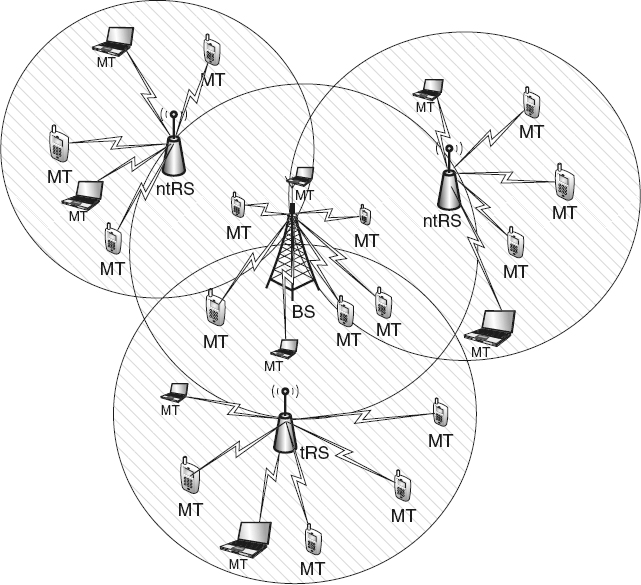Femtocells
Using RSs, the cellular network could enhance the communication experience of its users by shortening their transmission distances. However, the overall system traffic remained the same since RSs are directly communicating with the BSs. Alternatively, femtocells could reduce this traffic while reducing the transmission range to and from the MSs.
Figure 2.9 Network where non-transparent stations are used for capacity enhancement.
Femtocells have a very little upfront cost to the service provider and can result in very high capacity gains by making use of the wired broadband infrastructure that users already have in their homes/offices. In fact, studies on cellular usage patterns indicate that 70 % of the traffic originates from indoor environments, that is, homes and offices. This traffic requires high SNR levels in order to successfully deliver broadband services, which is challenging because indoor devices operating at gigahertz carrier frequencies suffer from serious attenuation losses. Consequently, the femtocell approach enhances the system capacity with a minimal infrastructure cost. It can also improve the communication quality of the users, hence pleasing both, the operator and the user.
A femtocell can be seen as a small home BS operating in the conventional licensed cellular bands, but with a short-range, a low-cost, and low transmit-power specifications. This customer-instauted BS, shown in Figure 2.10, communicates with the cellular network through a broadband connection (such as DSL or cable) already present at the user's premises. Unlike an RS, a femtocell does not communicate directly with any BS. Since its coverage area is small, a femtocell operates with low transmit power. Consequently, the penetration losses through walls and other infrastructure considerably limit the possible interference to the neighboring BSs and femtocells.
Figure 2.10 An example of a femtocell setup.
Access to the femtocell resources can either be open or closed. A femtocell with an Open Subscriber Group (OSG) allows access to any MS belong to the same network. A femtocell with a Closed Subscriber Group (CSG), on the other hand, allows access only to a limited set of users. A MS would be aware of which femtocells is a subscriber of. Note, however, that all femtocells are required to serve emergency calls, regardless of the MS's subscriber status. Meanwhile, it is possible for CSG femtocell to support a non-subscriber in certain critical instances, for example, priority handovers.
When a pre-authorized MS enters the coverage of a femtocell, it automatically switches affiliation from the serving BS, that is, macrocell, to the femtocell. Hence, initiating as well as receiving calls and data transmissions is performed as usual but through the femtocell instead. Next, this latter encrypts, using the Internet Protocol Security (IPSec), and sends the MS signals through the broadband Internet Protocol (IP) network to one of the switching centers.
Since MSs will be communicating with the local home BS, that is the femtocell, it is envisioned that their battery-lifetimes will be significantly prolonged. Moreover, offloading a fraction of the traffic to the femtocells will improve the macrocell, that is, BSs, reliability since it will be managing lesser traffic. This includes both, service reliability and resource provisioning. Moreover, operation and maintenance costs will also be substantially reduced. While the large operating and maintenance costs of BSs, including site leases, electricity, and backhaul connectivity, can reach as high as $60,000/year/macrocell BS, a femtocells costs as low as $200/year/femtocell. Even when femtocells are deployed in large numbers, it will remain a more economically viable alternative to setting up a new macrocell BS. Finally, a more consistent and satisfactory indoor service is predicted with femtocells, which will assist both service providers and customers in maintaining long lasting relationships.
Deploying femtocells, however, is not without challenges. A key driver for femtocell unit's cost reduction is the integration of software to silicon, termed “femtocell-on-a-chip,” to reduce the number of components needed per femtocell unit. Moreover, operators need to support remote software upgradability to provide service enhancements in a cost effective manner. Femtocell deployment also needs to abide by a single, industry-standard architecture to integrate femtocells to mobile core networks. Currently several femtocell architectures exist for different mobile technologies, for example, WiMAX, CDMA, LTE, which can lead to market fragmentation and hence reduces scalability of femtocell deployment.
Interference management will also be a major concern for femtocells. Femto-cells are installed by end-customers through broadband wired connection, which induces lack of coordination, especially frequency planning, between the macrocells BSs and the femtocells. The absence of centralized coordination also causes issues with timing/synchronization between femtocell and macrocell transmissions, which introduces challenges to minimizing interference and carrier offset, and facilitates macrocell-to-femtocell handovers. Meanwhile, macrocell users at the cell-edge might transmit at maximum power, which causes unacceptable interference to nearby femtocells. Similarly, cell-edge macrocell users' DL transmission can be disrupted by nearby femtocells due to their high path loss.
Handover can be a challenge to open-access femtocell deployments, especially macrocell-to-femtocell handover. In open access femtocells, a user might undesirably go through multiple handovers due to channel fluctuations when passing by multiple femtocells, which results in a degraded QoS. Another issue is QoS guarantee over the IP backhaul for delay sensitive traffic. This issue becomes more difficult when a femtocell shares the same connection with Wireless Local Area Network (WLAN), that is, Wi-Fi, traffic. In case of insufficient capacity, a traffic bottleneck where femtocells can experience difficulties transferring data and voice traffic over the broadband connection. Finally, users might choose to relocate their femtocells units outside the femtocell unit's home area. Femtocells operate on the home operator's licensed spectrum, where moving them to a visiting operator's area that uses the same spectrum might raise conflict.


